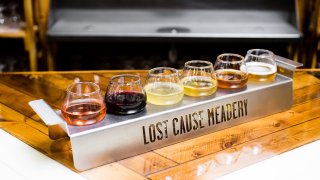
For a few decades now, San Diego has been distinctively known as the craft beer capital of America. In the early 1990s, the local wine industry began to take off in the county, as well, followed by other micro drink alternative scenes, like cider, sake and even kombucha. Now, it appears the success of these beverage businesses has helped spawn another: meadmaking.
For the last 10 years or so, meaderies, or wineries (mead makers operate under the winemaking license) where honey is fermented with water to create the alcoholic beverage mead, have been springing up in San Diego.
The first one, Golden Coast Mead, was founded in 2010 and opened its Oceanside location two years later. Since then, at least 10 others have also been established locally.
Frank Golbeck, founder, CEO and head mead maker at Golden Coast, is partially responsible for the recent growth in the local mead industry.
“We’ve helped a number of them (other local meaderies) get started,” said Golbeck, who got introduced to mead by his grandfather while studying international development in college. “When we got our own facility going and other mead makers were getting started, we offered our services and let them use our tanks, under our license. All they needed was retail distribution license instead of a production license.”
Golbeck said he worked with Twisted Horn Mead and Cider in Vista, Good Omen Mead and Hidden Hive Meadery, both in Escondido, and Honey Pot Meadery in Orange County, among others.

Giving Back
Local
The reason he wanted to help other mead makers grow their local mead businesses is because he faced some setbacks when he was attempting to get his going, said Golbeck. He said he reached out to about 80 wineries and breweries in town, and only got a handful of responses back, all of which said they couldn’t help. It wasn’t until he reached out to Triple B Ranches in Valley Center that he found a willing partner, he said.
They said “we can help you out — let’s do a custom crush, or basically a production contract,” he said, adding that, as a result, Golden Coast was able to grow from five home brew batches to three hundred commercial batches.
He calls his collaboration with other meadmakers “coopetition,” a play on the words “cooperation” and “competition,” and said the current players in the local mead industry have all figured out their niche, which keeps things copacetic. Golden Mead’s, for example, is a sour, tart mead that is gluten-free, preservative-free and full of probiotics, said Golbeck.
“I think our craft brew culture really contributes” to the growth of the mead industry, he said. “San Diegans care about nature… There are also a lot of foodies here, lots of culinary options… So, we help each other grow, and in doing so, we help the entire mead market grow.”
Mark Oberle, owner and mead maker at San Marcos-based Meadiocrity Mead, founded in 2016, said San Diego is a fitting location for the budding mead industry.
Demand for New Tastes
“There is a constant demand for new beer, new wines and new craft drinks,” he said, “and drinkers within San Diego are engaged with the culture where their beverage comes from. Mead is a natural fit — it’s a unique beverage produced in San Diego and the raw ingredients come from San Diego as well. Some wineries may do that, but, typically, breweries don’t since they buy their grains from outside of San Diego.”
Meadiocrity, which does its own beekeeping (most others buy blended and filtered honey, he said) and focuses on accentuating the honey characteristics, opened its 3,400 square foot San Marcos location with a tasting room early October. He said the reason he chose to make beekeeping a part of his mead-making process is because he believes this is what gives the Meadiocrity mead its distinct character.
Finding Flavors
“Our beekeepers will move to make sure (the bees) have food, which changes what forage they have,” he said, adding that, as a result, the honey used in the Meadiocrity mead showcases the cultivated crops in San Diego.
“While orange blossoms were blooming, they were getting that orange flavor. Then they moved to buckwheat and sage. The combination of those nectars comes together within the honey which gives the mead aromatics of orange blossoms and herbal notes… So, we have different honeys based on blossoms,” he added.
Oberle explained that, while no one can date the first instance of the beverage, mead is the oldest alcoholic drink in the world; he said there are some findings in China that date back several thousand years.
The way mead is created, he said, is by mixing honey, water and yeast, the latter either wild or cultivated. The alcohol levels in mead can vary, between 3% and even above 20%, although the highest Meadiocrity makes is 13.5%, he said.
Oberle said, traditionally, a meadmaker uses up to three pounds of honey per gallon of starting mead mixture. Aside from being available at its tasting room, Meadiocrity mead is also available in Trader Joe’s and a couple of other smaller national retailers.
 Additional stories from the San Diego Business Journal are available here. Sign up for their free daily email newsletter.
Additional stories from the San Diego Business Journal are available here. Sign up for their free daily email newsletter.



